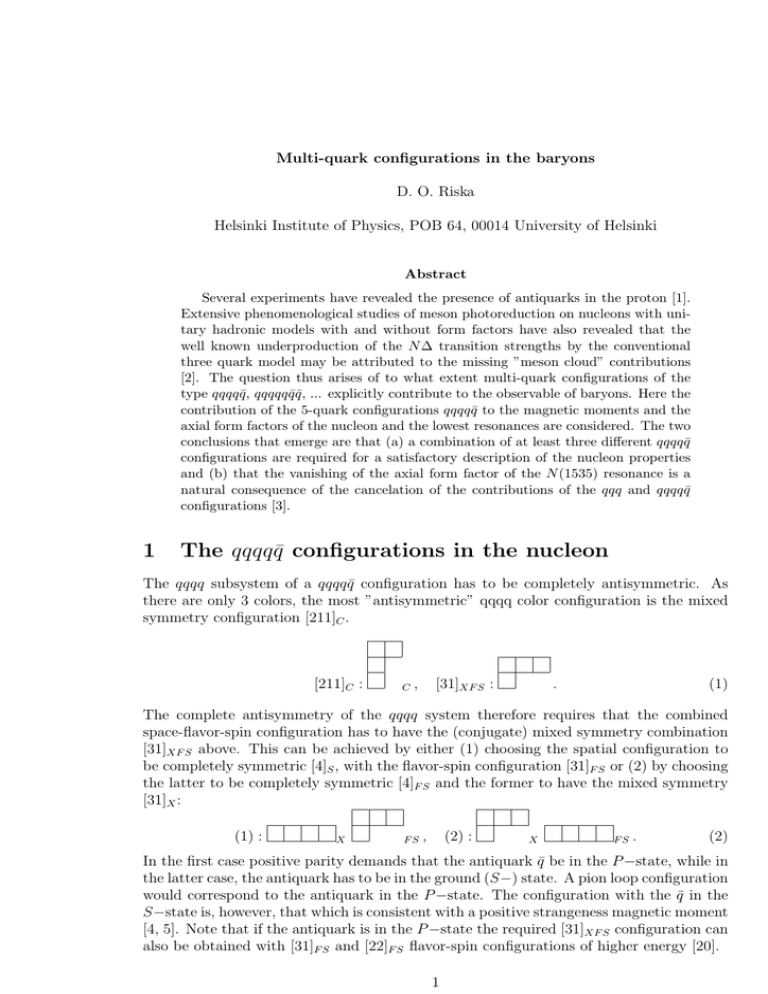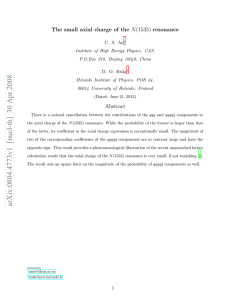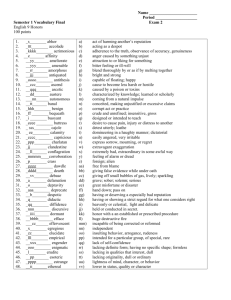1 The qqqq¯q configurations in the nucleon
advertisement

Multi-quark configurations in the baryons
D. O. Riska
Helsinki Institute of Physics, POB 64, 00014 University of Helsinki
Abstract
Several experiments have revealed the presence of antiquarks in the proton [1].
Extensive phenomenological studies of meson photoreduction on nucleons with unitary hadronic models with and without form factors have also revealed that the
well known underproduction of the N ∆ transition strengths by the conventional
three quark model may be attributed to the missing ”meson cloud” contributions
[2]. The question thus arises of to what extent multi-quark configurations of the
type qqqq q̄, qqqqq q̄ q̄, ... explicitly contribute to the observable of baryons. Here the
contribution of the 5-quark configurations qqqq q̄ to the magnetic moments and the
axial form factors of the nucleon and the lowest resonances are considered. The two
conclusions that emerge are that (a) a combination of at least three different qqqq q̄
configurations are required for a satisfactory description of the nucleon properties
and (b) that the vanishing of the axial form factor of the N (1535) resonance is a
natural consequence of the cancelation of the contributions of the qqq and qqqq q̄
configurations [3].
1
The qqqq q̄ configurations in the nucleon
The qqqq subsystem of a qqqq q̄ configuration has to be completely antisymmetric. As
there are only 3 colors, the most ”antisymmetric” qqqq color configuration is the mixed
symmetry configuration [211]C .
[211]C :
C
,
[31]XF S :
.
(1)
The complete antisymmetry of the qqqq system therefore requires that the combined
space-flavor-spin configuration has to have the (conjugate) mixed symmetry combination
[31]XF S above. This can be achieved by either (1) choosing the spatial configuration to
be completely symmetric [4]S , with the flavor-spin configuration [31]F S or (2) by choosing
the latter to be completely symmetric [4]F S and the former to have the mixed symmetry
[31]X :
(1) :
X
FS
,
(2) :
X
FS
.
(2)
In the first case positive parity demands that the antiquark q̄ be in the P −state, while in
the latter case, the antiquark has to be in the ground (S−) state. A pion loop configuration
would correspond to the antiquark in the P −state. The configuration with the q̄ in the
S−state is, however, that which is consistent with a positive strangeness magnetic moment
[4, 5]. Note that if the antiquark is in the P −state the required [31]XF S configuration can
also be obtained with [31]F S and [22]F S flavor-spin configurations of higher energy [20].
1
Table 1: Magnetic moments for the qqqq q̄ configurations in the nucleon
qqqq symmetry
configuration
[31]X [4]F S [22]F [22]S
[31]X [4]F S [31]F [31]S
[31]X [4]F S [31]F [31]S
[4]X [31]F S [22]F [31]S
[4]X [31]F S [22]F [31]S
[4]X [31]F S [31]F [22]S
[4]X [31]F S [31]F [31]S
[4]X [31]F S [31]F [31]S
proton
neutron
0
2/9
-1/3
7/27
-4/27
-2/9
-19/27
508/729
1/3
-2/9
0
-23/27
0
0
1/9
-95/729
qqqq : J = 1
qqqq : J = 0
q̄ : J = 3/2
q̄ : J = 1/2
q̄ : J = 3/2
q̄ : J = 1/2
No qqqq q̄ component alone can achieve the remarkable −3/2 ratio between the proton
and the neutron magnetic moments, which is characteristic of the basic qqq configuration
in both its nonrelativistic and relativistic versions [6]. This may be inferred from Table
1, where the nucleon magnetic moments for the 7 possible qqqq q̄ configurations in the
nucleons are listed. This may also inferred from the comprehensive attempt in ref.[7] to
combine only the first of these qqqq q̄ configurations with the basic qqq configuration.
The desired -3/2 ratio can however be obtained with a linear combination of the qqq
and the first 3 configurations in the table:
q
ψ=
v
u
u
P3 ϕ[3][21][21] +t
s
q
q
P5
2
2
J=1
{
b
+
b
ϕ
+
b
ϕ
+
b2 ϕJ=0
1
2 [4][22][22]
1 [4][31][31]
[4][31][31] }. (3)
11
5
9
3
b
+
b
9 1
3 2
Here P3 and P5 are the probabilities for the qqq and (total) qqqq q̄ components. The
symmetry assignments [F S][F ][S] in the wave functions represent flavor×spin, flavor and
spin respectively. The q̄ components in the qqqq q̄ wavefunctions is to be understood. A
combination of the form (3) with 68 % qqq and 32 % of these qqqq q̄ can in fact be arranged
to yield the empirical value for gA (n → p), eg by taking b1 = b2 .
The identification of specific multi-quark contributions in the nucleon form factors is
difficult because of their smooth behavior, which may be reproduced by a large variety
of models. The prospective node in the region above Q2 ∼ 6 GeV2 in GpE [8] does for
example arise naturally already in the case of the qqq configuration if calculated with
front form kinematics [9], although it also arises if a qqqq q̄ component is included, the
magnitude and form of which are set by the empirical values for GnE [10]. The electric
form factor of the neutron GnE , which vanishes in the nonrelativistic qqq model, can in
fact be brought into agreement with the empirical values by including a mixed symmetry
S−state in the nucleon wave function with a probability of 1 − 2 % [9].
2
The qqqq q̄ configurations in the nucleon resonances
While it is possible to achieve a qualitative description of the lowest baryon resonances
with the basic qqq model with spin and flavor dependent interactions [11], that model does
2
Table 2: The qqqq q̄ configurations in the N (1535) and the corresponding axial charge
coefficient An (4) [19].
configuration qqqq flavor-spin
qqqq color-spin
An
1
2
3
4
5
[31]F S [211]F [22]S
[31]F S [211]F [31]S
[31]F S [22]F [31]S
[31]F S [31]F [22]S
[31]F S [31]F [31]S
[31]CS [211]C [22]S
[31]CS [211]C [31]S
[22]CS [211]C [31]S
[211]CS [211]C [22]S
[211]CS [211]C [31]S
0
+5/6
−1/9
−4/15
+17/18
not describe the systematics of the resonance decay widths. In the case of the ∆(1232) and
the N (1440) resonances it has been shown that the inclusion of a qqqq q̄ component in the
wave function makes it possible to overcome the underpredictions of the electromagnetic
and strong decay widths [12, 13, 14]. Such calculations are however only qualitative in
that the cross term matrix elements between the qqq and qqqq q̄ components are very
sensitive to the wave function models.
The cross terms between the qqq and the qqqq q̄ configurations are large when the
operator, which connects the annihilating q q̄ pair and the meson or the γ ray involves
the ”large” components of the Dirac spinors. When the operator involves the small
components, which is the case of the axial charge operator, the cross terms are suppressed.
In this context the recent lattice result that the axial charge of the N (1535) is very
small - if not 0 - is particularly interesting [15]. If the corresponding result for the (near)
parity partner N (1440) would also be close to 0, that might actually indicate the onset
of restored chiral symmetry [16]. As the configuration mixing between the N (1535) and
the following 1/2− resonance N (1650) is expected to be small [17, 18], these resonances
may be considered separately.
The general expression for the axial charge of the N (1535) is
gA∗ '
X
An Pn ,
n = 3, 5, ..
(4)
n
where n is the number of constituents ((n + 3)/2 is the number of quarks and (n − 3)/2
the number of antiquarks). Since the qqq model value for gA∗ is −1/9 [16], it follows that
if indeed the axial charge of the N (1535) vanishes, the multiquark configurations with
n > 3 have to cancel that value.
Consideration of the qqqq q̄ components indicates that this would be a very natural
result [3]. In Table 2 all the possible qqqq q̄ configurations in the N (1535) and the corresponding coefficients An in the axial charge expression 4 are listed. These are listed in
order of increasing energy under the assumption that the interaction between the quarks
depend on spin and flavor or color.
Inclusion of these qqqq q̄ components in addition to the qqq component leads to the
axial charge expression,
5 (2) 1 (3)
4 (4) 17 (5)
1
gA (N (1535)) = − P3 + P5 − P5 − P5 + P5 ,
9
6
9
15
18
(5)
where the coefficients P indicate the corresponding probabilities. Because two of the
qqqq q̄ components have large positive coefficients, while the qqq contribution has a small
3
negative coefficient it is possible to cancel the latter contribution altogether with only
modest probabilities of the qqqq q̄ components [19].
Combination of this result with the lattice calculation result for the axial charge of the
N (1650) resonance [15], which is close to the qqq quark model value 5/9 [16], suggests the
conclusion that the smallness of the axial charge of the N (1535) is a natural consequence
of its quark configuration and (possibly also) the cancelation between the contributions
of the qqq and the qqqq q̄ components [19] rather than an indication of restored chiral
symmetry.
References
[1] G.Garvey and J.C.Peng, Prog.Part.Nucl.Phys. 47, 203 (2001)
[2] B. Juliá-Dı́az et al., Phys. Rev. C 75, 015205 (2007)
[3] C. S. An and D. O. Riska, Eur.Phys.J A37, 263 (2008)
[4] B. S. Zou and D. O. Riska, Phys. Rev. Lett. 95, 072001 (2005)
[5] J. Liu, R. D. McKeown and M. Ramsey-Musolf, Phys. Rev.C 76, 025202 (2007)
[6] B. Juliá-Dı́az and D. O. Riska, Nucl. Phys. A 739, 69 (2004)
[7] C. S. An, Q. B. Li and D. O. Riska, Phys. Rev. C 74, 055207 (2006), C 75, 069901
(2007)
[8] O. Gayou et al.. Phys. Rev. Lett. 88, 092301 (2002)
[9] B. Juliá-Dı́az, D.O. Riska and F. Coester, Phys. Rev. C 69, 035212 (2004), C75,
069902 (2007)
[10] Q. B. Li and D. O. Riska, Nucl.Phys. A 791, 406-421 (2007)
[11] L. Ya. Glozman and D. O. Riska, Phys. Rept. 268, 263 (1996)
[12] Q. B. Li and D. O. Riska, Phys.Rev. C 73, 035201 (2006)
[13] Q. B. Li and D. O. Riska, Nucl.Phys. A 766, 172 (2006)
[14] Q. B. Li and D. O. Riska, Phys.Rev. C 74, 015202 (2006)
[15] T. T. Takahashi and T. T. Kunihiro, Phys. Rev. D 78, 01150(R) (2008)
[16] L. Ya. Glozman and A. V. Nefediev, Nucl. Phys. A 807, 38 (2008)
[17] J. C. Nacher et al., Nucl. Phys. A 678, 187 (2000)
[18] D. Pirjol and C. Schat, arXiv: 0906.0802 [hep-ph]
[19] C. S. An and D. O. Riska, Eur.Phys.J. A37, 263-265 (2008)
[20] C. Helminen and D. O. Riska, Nucl. Phys. A699, 624 (2002)
4

